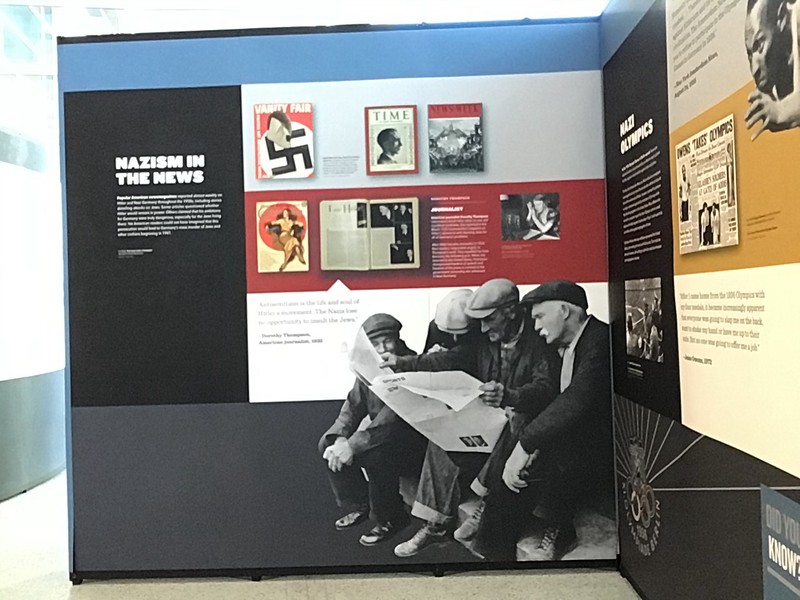Nazism in the News (Americans and the Holocaust Exhibit)
Introduction
Author-Uploaded Audio
"Nazism in the News" audio tour clip, part of the Americans and the Holocaust Exhibit
Text-to-speech Audio
The first section of the exhibition asks what Americans could have known about the Nazi persecution of Jews. As soon as Adolf Hitler was appointed chancellor of Germany in 1933, he immediately began amassing power, and within two years was a dictator. The Nazi party was quickly the only political party allowed in Germany, and Hitler’s government immediately began persecuting German Jews. Jews were fired from their jobs in government and at universities, Jewish shops were boycotted, and books written by Jews and the Nazis’ political opponents were burned in the streets. News of Nazi Germany and Nazi persecutions were on the front pages of American newspapers and on the covers of American magazines.
Please view the magazine in the center of the top row. This is the cover of Newsweek magazine from the summer of 1933. Joseph Goebbels [pronounced Gerbulls], the Nazi propaganda minister, is pictured. What is the line under the picture?
Right. “Say it in your dreams, the Jews were to blame.” So Americans had information about Nazi antisemitism as soon as Hitler came to power in Germany. The Goebbels tagline reminded American readers that antisemitism (prejudice or hatred towards Jews) was central to Nazi ideology. At the kiosk over here, which we’ll walk over to now, you can explore nationwide newspaper coverage in the United States of the Nazi treatment of Jews.
Walk to the West Window Kiosk. As you can see, even locally, there was news coverage of these events, which people in our state could have read. These are just a few samples of the thousands of American newspaper articles that covered the Nazi regime. Please feel free to come back and explore this interactive screen later. You can also participate in the Museum’s “History Unfolded” project to collect local news coverage of the Holocaust, and the librarians can help you do this.
Images
Nazism in the News panel

Backstory and Context
Text-to-speech Audio
Metropolitan Library System is one of 50 U.S. libraries selected to host AMERICANS AND THE HOLOCAUST, a traveling exhibition from the U.S. Holocaust Memorial Museum that examines the motives, pressures, and fears that shaped Americans’ responses to Nazism, war, and genocide in Europe during the 1930s and 1940s.
The Americans and the Holocaust exhibit will be on display at the Downtown Library, along with a series of related special events from Thursday, January 5 to Sunday, February 12.
Based on extensive new research of that period, Americans and the Holocaust addresses important themes in American history, exploring the many factors — including the Great Depression, isolationism, xenophobia, racism, and antisemitism — that influenced decisions made by the U.S. government, the news media, organizations and individuals as they responded to Nazism. This exhibition will challenge the commonly held assumptions that Americans knew little and did nothing about the Nazi persecution and murder of Jews as the Holocaust unfolded.
Drawing on a remarkable collection of primary sources from the 1930s and ’40s, the exhibition focuses on the stories of individuals and groups of Americans who took action in response to Nazism. It will challenge visitors to consider the responsibilities and obstacles faced by individuals — from Franklin Delano Roosevelt to ordinary Americans — who made difficult choices, sought to effect change, and, in a few cases, took significant risks to help victims of Nazism even as rescue never became a government priority.
Sources
United States Holocaust Memorial Museum. Accessed January 5th, 2023. https://www.ushmm.org/.
American Library Association. Accessed January 5th, 2023. https://www.ala.org/.
